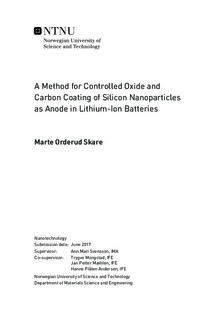A Method for Controlled Oxide and Carbon Coating of Silicon Nanoparticles as Anode in Lithium-Ion Batteries
Master thesis
Permanent lenke
http://hdl.handle.net/11250/2454365Utgivelsesdato
2017Metadata
Vis full innførselSamlinger
Sammendrag
Silicon has emerged as a promising alternative to graphite in lithium-ion batteries.Silicon can, theoretically, provide up to ten times higher capacity due to its highalloying capabilities with lithium. This improvement in initial capacity is howeverfollowed by capacity fade during the early cycles, which is undesirable for commercialapplications. The low cycle life is in turn due to the high alloying withlithium, as this leads to a large volume expansion and subsequent contraction ofthe material.
In this work, a method for coating silicon has been investigated to eventually beable to buffer the volume change associated with cycling. Double core-shell particleswere fabricated by wet chemical methods, and can serve as a base for creatingyolk-shell particles in the future. Silicon nanoparticles from a Free Space Reactorwith diameters between 50 nm and 1 ¹m have successfully been coated witha 50-80nm thick oxide layer by the use of tetraethyl orthosilicate, designed to be asacrificial layer to be etched away at a later state. Following the oxide layer, a thincarbon-coating has been applied by a resorcinol-formaldehyde resin and pyrolysis,which interconnects the oxide coated particles in a web-like morphology. Thecoating steps have been thoroughly characterized by electron microscopy, energydispersive spectroscopy, x-ray diffraction, thermogravimetric analysis, dynamiclight scattering and nitrogen adsorption. Problems related to the upscaling of thisprocess were revealed during carbon-coating, as it did not give sufficient controland reproducibility with coating thickness and morphology for the chosen startingmaterial.
Li-ion battery half-cells were prepared with the reference silicon and electrochemicallycycled, and one half-cell exhibited a superior lifetime (up to 1,000 cycles)when cycled at a reversible capacity of 700 mAh/g, while others could retain 1,200 mAh/g for only 150 cycles. The cycling of both amorphous and crystalline silicon was done, but no lifetime-dependence on crystallinity was found. Crystalline silicon anodes with a loading of 0.4 mg/cm2 displayed an irreversible capacity loss (ICL) in the first cycle of 8-9%, and a reversible capacity of 1,750 mAh/g for 120 cycles, while a higher loading of 0.5 mg/cm2displayed the same ICL but a capacity of 2,500 mAh/g for only 50 cycles. Amorphoussilicon anodes with a loading of 0.5 mg/cm2 displayed a low ICL of 1%,and a reversible capacity of 2,000 mAh/g for 70 cycles. The lifetimes are clearlymore dependent upon loading and cell fabrication, than of initial crystallinity ofthe material.
In sum, this work has provided a starting point for the fabrication of yolk-shell particlesby using Si nanoparticles from an FSR. A homogeneous coating of oxide hasbeen applied, and a carbon coating was observed for a few samples. Electrochemicalresults from the cycling of pure silicon showed a high dependence on loadingand cell fabrication, and it is therefore imperative to keep the electrode fabricationand cell assembly as similar as possible for comparison purposes.
